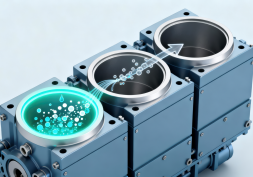MORPHing metamaterials into biomarker-detection powerhouses
Follow CDE
PDF Download

Molecular diagnostics get a shot in the arm with hydrogel-based metamaterials, enhancing precision and speed in identifying critical biomarkers for disease monitoring.
Smart materials, from sunlight-responsive windows to shape-shifting alloys in medical devices to self-powered light sensors, play an increasingly integral role in our everyday lives due to their ability to react to various external stimuli such as light, temperature or moisture.
Among smart materials, metamaterials stand out for their engineered structures with unique properties not commonly found in nature. With rationally designed patterns, these materials work in unison to offer precise control and unprecedented functionalities. This characteristic renders them versatile across many applications, ranging from advanced optics to medical technologies, through the manipulation of energy and signals in novel ways.
At the College of Design and Engineering, National University of Singapore, researchers have achieved a breakthrough in biomolecule profiling by designing a hydrogel-based metamaterial specially engineered to visually detect the presence of extracellular vesicles in patient samples, with potential applications in disease diagnosis and monitoring.
Led by Associate Professor Shao Huilin, the team’s research was published in Nature Biomedical Engineering on 27 October 2022.
Unlocking the biomedical potential of metamaterials
Mechanical metamaterials have recently garnered interest in biomedicine for applications in diagnostics and treatments as they can dramatically alter an object’s mechanical response through their structured composition.
Take, for instance, metamaterials with a lattice structure. Such materials have a negative Poisson’s ratio — meaning they expand laterally when stretched, in contrast to most that tend to contract. This makes them highly valuable in crafting impact-resistant materials and in the design of medical implants.
Yet, the full potential of these materials in medical applications remains largely untapped. A key challenge in harnessing mechanical metamaterials for biomedical purposes lies in their limited response range, especially when considering hydrogels.
While hydrogels are responsive to environmental changes, their structural flexibility during preparation can compromise the precision required for biomedical applications. They also react rather slowly. Molecules within a hydrogel network interact with one another via gradual diffusion, which limits its ability to detect changes swiftly and accurately in different areas.
MORPHing molecular diagnostics
In response to these challenges, Assoc Prof Shao’s team introduced the MORPH system — a hydrogel-based mechanical metamaterial operating at a critical point for hyper-responsive analysis.
“The hydrogel is specially designed for detailed molecular profiling at the nanoscale, making it highly sensitive to specific biological markers,” said Assoc Prof Shao. “When it encounters targeted biomarkers, such as extracellular vesicles specific to cancer patient samples, an antibody-antigen binding reaction occurs. Here, antibodies that integrated into the hydrogels bind with these biomarkers.”
This interaction triggers a physical transformation in the hydrogel’s structure, which is further intensified by plasmonic heating. This ensures that the hydrogel remains in a sensitive transition state — primed to react to the slightest biomolecular shifts. As a result, these shifts are easily detectable using simple optical methods, including tools as simple as a smartphone camera — enhancing the system’s practicality in clinical settings.
Expanding diagnostic horizons
With enhanced sensitivity and specificity, the MORPH system can be precisely fine-tuned to various biomolecular stimuli, especially in analysing exosomes. This shows promise for early detection in a spectrum of diseases, including cancers and neurodegenerative disorders.
“There’s room for incorporating a wider range of bio-responsive hydrogels to boost the system’s responsiveness. This could open new avenues for detecting and analysing transient molecular interactions,” adds Assoc Prof Shao, highlighting the system’s versatility.
The researchers also explored adapting the system to develop complex 3D architectures, including designs inspired by Japanese origami and kirigami. Crafting such intricate metamaterials could bring about sophisticated methods in signal transduction and amplification, all of which refine the system’s analytical capabilities. Translating these techniques to biomedicine could lead to faster biomarker discovery, a better understanding of disease progression and more effective personalised medicine and diagnostics.
Related
Shao Huilin ▏Associate Professor, Department of Biomedical Engineering ▏LinkedIn Profile
Related Departments
Read More
View Our Publications ▏Back to Forging New Frontiers - April 2024 Issue
If you are interested to connect with us, email us at cdenews@nus.edu.sg








